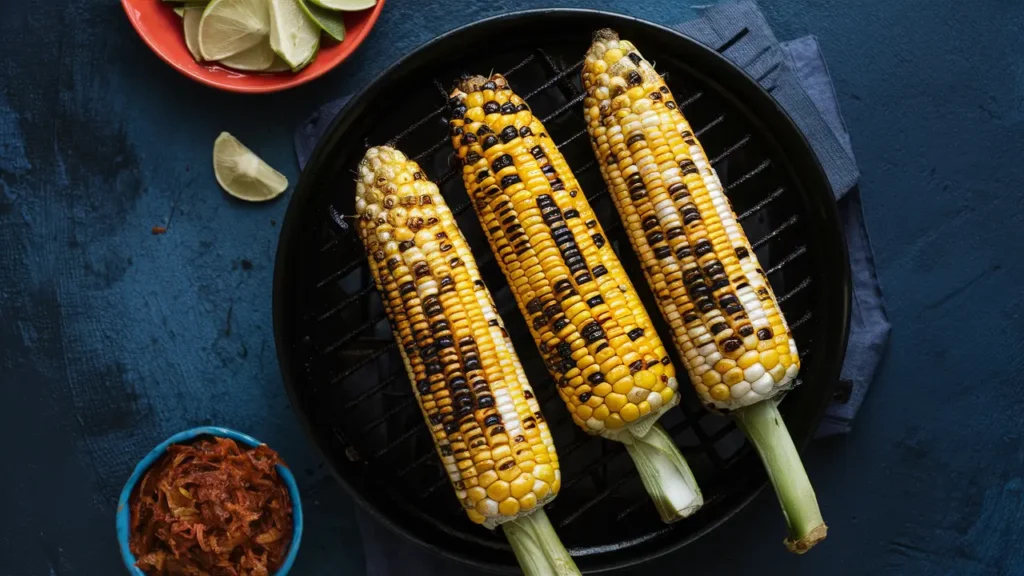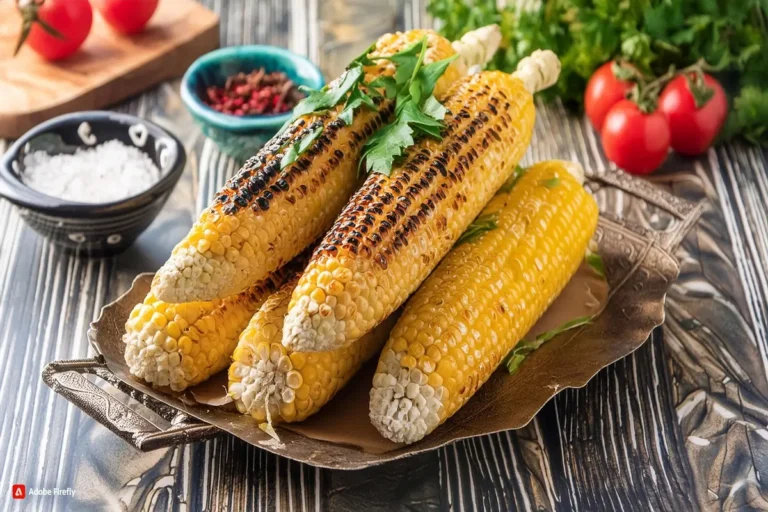I. Introduction to Elote
Elote, also known as Mexican street corn, is a popular snack found in Mexico, loved for its savory, creamy, and tangy flavors. This delightful dish is not only a staple at Mexican street fairs but has also gained immense popularity across the United States and other countries. This introduction will explore what elote is and discuss its cultural significance and popularity.
A. Definition and Description of Elote
Elote is traditionally made with corn on the cob, which is boiled or grilled and then coated in a layer of mayonnaise, sour cream, or crema. The corn is then sprinkled generously with cotija cheese, a hard, crumbly Mexican cheese, and seasoned with chili powder, salt, and lime juice. Here’s a detailed description:
- Corn Preparation: The corn is typically grilled to add a smoky flavor, though it can also be boiled. Grilling the corn until slightly charred adds depth to the final taste.
- Toppings:
- Mayonnaise/Creama: Acts as the binding agent for other toppings.
- Cotija Cheese: Adds a salty, creamy texture that contrasts beautifully with the sweet corn.
- Chili Powder: Provides a hint of spice that complements the sweetness of the corn.
- Lime Juice: Adds brightness and tanginess, enhancing all the other flavors.
- Serving: Elote is typically served on a stick for convenient eating, making it an ideal grab-and-go snack option.
B. Overview of Its Cultural Significance and Popularity
Elote holds a special place in Mexican culture, primarily due to its origins as a street food that is both affordable and filling. Here’s an overview of its cultural significance and popularity:
- Cultural Roots:
- Street Food Staple: In Mexico, elote is a ubiquitous street food sold by vendors who set up carts in town squares and along bustling streets. It’s a favorite during festivals, adding to the culinary festivities.
- Family and Community: Enjoying elote is viewed as a communal experience, frequently shared during family gatherings or community events, further enriching its cultural significance.
- Global Popularity:
- Adaptation and Fusion: As elote has journeyed beyond Mexico’s borders, it has undergone various adaptations, incorporating local flavors and ingredients, thereby enhancing its popularity worldwide.
- Culinary Experimentation: In the US and other countries, elote has inspired a range of culinary creations, from elote-inspired dips to dishes featuring elote as a key ingredient.
- Iconic Mexican Dish: Its popularity abroad has also led to a greater appreciation and recognition of Mexican cuisine in general, making it a beloved dish among food enthusiasts around the world.
Elote’s perfect blend of sweet, savory, creamy, and tangy flavors, combined with its cultural richness, makes it much more than just a snack—it’s a vibrant part of Mexican culinary heritage that continues to capture the hearts of people globally. In the following sections, we will delve into how to prepare elote, exploring the necessary ingredients and steps to bring this flavorful dish to life.

II. Ingredients of Elote
Elote, a cherished street food found throughout Mexico and increasingly popular worldwide, combines simple ingredients that create a complex flavor profile. This section breaks down the primary ingredients used to make traditional elote and explores the variations and regional differences that add a unique twist to each serving.
A. Primary Ingredients Used in Elote
The classic version of elote involves a handful of key ingredients, each contributing to the dish’s vibrant flavors and textures:
- Corn on the Cob:
- Type: Ideally, mature and sweet corn is preferred for elote, as it offers the desired sweetness and juiciness to the dish.
- Preparation: Traditionally, the corn is grilled over an open flame until lightly charred, infusing it with a distinctive smoky flavor that defines elote.
- Mayonnaise or Mexican Crema:
- Mayonnaise: Provides a creamy coating that helps other toppings adhere to the corn. Mayonnaise is popular for its rich texture and flavor.
- Mexican Crema: A thinner, tangier alternative to sour cream, often used for a more authentic taste.
- Cotija Cheese:
- Description: A hard, crumbly cheese from Mexico that offers a sharp, salty flavor contrasting with the sweetness of the corn.
- Substitutions: If cotija cheese is unavailable, Parmesan or feta cheese can be used as alternatives to achieve a similar savory flavor in the elote.
- Chili Powder:
- Type: A blend of dried, powdered chilis provides heat and depth. Specific types used can vary, affecting the heat level and color of the elote.
- Alternatives: Depending on preferred spice levels, cayenne pepper or paprika can serve as substitutes for adding a kick to the elote.
- Lime:
- Usage: Lime wedges are commonly utilized to squeeze fresh lime juice over the cooked corn, imparting a vibrant, citrusy note that complements the creamy and salty flavors perfectly.
- Salt:
- Purpose: Enhances all the flavors and balances the sweetness of the corn.
These ingredients together create a delightful contrast of flavors and textures—creamy, tangy, spicy, and salty, all harmonizing with the natural sweetness and smokiness of the corn.
B. Variations and Regional Differences in Ingredients
While the traditional elote holds a special place in the hearts of many, a plethora of regional variations exist, each contributing its unique local flavor and character to this beloved dish.
- Toppings and Spices:
- Butter or Margarine: In certain regions, butter or a buttery spread is used in place of, or alongside, mayonnaise to impart a richer flavor to the elote.
- Hot Sauce or Salsa: A drizzle of hot sauce or a spoonful of salsa can add heat and acidity.
- Cilantro: Adding chopped cilantro provides a fresh and herbal note to the elote.
- Garlic: Incorporating minced garlic or garlic powder into the mayonnaise enhances the flavor with an extra punch.
- Cheese Variations:
- Queso Fresco: Offering a softer and milder taste compared to cotija, queso fresco adds a delicate cheese flavor to dishes.
- Ancho Chile Powder: Used instead of generic chili powder for a deeper, more complex chili flavor.
- Preparation Styles:
- Boiled Corn: Though grilling is traditional, boiling is also a common preparation method, particularly where grilling facilities are not available.
- Esquites: A beloved variation where cooked corn kernels are removed from the cob, mixed with the same ingredients, and served in a cup, perfect for enjoying with a spoon.

III. Origins of Elote
Elote, or Mexican street corn, is more than just a popular snack; it is a cultural symbol with deep historical roots in Mexico’s culinary and agricultural traditions. This section will trace the origins of elote, exploring its cultural and historical background, and discuss its significance and traditional uses in Mexican society.
A. Tracing the Roots of Elote to Its Cultural and Historical Origins
Maize Connection: Elote’s history is inseparable from the history of maize (corn), a staple crop cultivated in Mexico for millennia.
- Historical Background:
- Domestication of Maize: Maize was first domesticated by indigenous peoples in central Mexico around 7000 years ago, based on archaeological evidence. It has since become a cornerstone of Mesoamerican civilizations culturally, economically, and nutritionally.
- Ancient Uses: Ancient civilizations, including the Mayans and Aztecs, revered maize as a sacred plant. It was not only their main food source but also featured prominently in their religious rituals and mythology.
- Development of Elote:
- Pre-Columbian Origins: The tradition of eating corn on the cob dates back to pre-Columbian times when indigenous peoples cooked corn directly over open fires.
- Culinary Evolution: Over centuries, as Mexican cuisine evolved, so did the ways of seasoning and serving corn. The introduction of livestock and dairy products by the Spanish colonizers added cheese and cream—ingredients now typical in contemporary elote recipes.
B. Cultural Significance and Traditional Uses of Elote
Elote holds a special place in Mexican culture, both as a cherished everyday food and a festive treat.
- Symbol of Heritage:
- Indigenous Roots: Elote is a reminder of Mexico’s rich indigenous heritage and the ancient civilizations’ agricultural advances.
- Modern Day Icon: Today, it symbolizes the fusion of pre-Hispanic and post-Colonial culinary practices, representing Mexico’s complex history and rich cultural tapestry.
- Street Food Culture:
- Accessibility and Popularity: As a street food, elote is widely accessible and affordable, making it a popular choice among locals and tourists alike. It is commonly sold at street carts, markets, and festivals, often seasoned to order.
- Festive Associations: Elote gains special popularity during festivals and public celebrations, delighting people of all ages with its flavorful appeal. It is not just food but a part of the festive activities that bring communities together.
- Traditional Uses:
- Everyday Snack: Beyond its festive use, elote is a common everyday snack, cherished for its taste and nutritional value.
- Varietal Enjoyment: Elote is savored in diverse forms—on the cob (elote) or in a cup (esquites), where kernels are shaved off the cob and mixed with the same delectable ingredients.
- Culinary Influence:
- Inspiration Beyond Borders: Elote’s concept has sparked numerous adaptations in global cuisines, integrating its creamy, tangy, and spicy elements into diverse dishes.
- Adaptability: Its ingredients and preparation methods have evolved, reflecting local tastes and ingredient availability, from the use of mayonnaise to different types of cheeses and spices.
IV. Preparation of Elote
Preparing elote involves a few crucial steps that combine traditional cooking techniques with flavorful toppings to create a delightful snack. This section outlines the detailed steps involved in preparing elote and discusses the techniques for grilling or roasting corn which are essential to achieve the perfect flavor and texture.
A. Steps Involved in Preparing Elote
Creating elote can be a simple process that yields delicious results. Here’s how to make it:
- Select and Clean the Corn:
- Choose fresh, plump corn on the cob with green husks and no brown holes, which indicate worm activity.
- Remove the husks and silk from the corn. Some people prefer to leave a bit of the husk for a handle or remove it entirely.
- Cook the Corn:
- You can either grill, roast, or boil the corn. Grilling or roasting is preferred for the smoky flavor it imparts.
- Prepare the Toppings:
- Mix the Creamy Base: In a bowl, combine mayonnaise, sour cream, or Mexican crema with a pinch of salt. Adjust the proportions based on your taste preference.
- Prepare Additional Toppings: Crumble the cotija cheese, slice the lime into wedges, and measure out the chili powder.
- Cooking the Corn (Detailed in Part B):
- Follow the specific techniques for grilling or roasting as outlined below.
- Assemble the Elote:
- Once the corn is cooked and slightly cooled, brush it liberally with the creamy base mixture.
- Roll the coated corn in crumbled cotija cheese until thoroughly covered.
- Sprinkle with chili powder to taste.
- Squeeze lime juice over the corn for a tangy finish.
- Serve:
- Insert a stick into one end of the cob if desired, for easier handling.
- Serve hot, garnished with extra lime wedges and a sprinkle of fresh cilantro if liked.
B. Techniques for Grilling or Roasting Corn for Elote
The method of cooking the corn significantly affects the final taste and texture of elote. Here are the techniques for grilling and roasting:
Grilling Corn:
- Preheat the Grill:
- Heat your grill to a medium-high heat (about 350°F to 450°F).
- Prepare the Corn for Grilling:
- Brush the corn lightly with oil (vegetable or olive oil works well).
- Optionally, you can season the corn with salt and pepper before placing it on the grill.
- Grill the Corn:
- Place the corn directly over the heat source.
- Let the corn grill for about 10 to 15 minutes, turning every 2 to 3 minutes to ensure even charring and cooking.
- The corn should develop a slightly charred, golden-brown appearance with some blackened spots.
Roasting Corn:
- Oven Setup:
- Preheat your oven to 400°F.
- Prepare the Corn for Roasting:
- Similar to grilling, brush the corn with oil and optionally season with salt and pepper.
- Wrap each cob individually in aluminum foil if preferred, which can help steam the corn as it roasts.
- Roast the Corn:
- Place the corn directly on the oven rack or on a baking sheet.
- Roast for about 20 to 30 minutes, turning halfway through the cooking time.
- The corn should be tender and lightly caramelized.
Pro Tips:
- Flavor Infusion: For an added flavor boost, consider adding butter, garlic, and herbs (such as cilantro or parsley) to the corn before grilling or roasting.
- Checking Doneness: Corn is done when it is tender and juicy. The kernels should pierce easily with a fork.
By following these steps and techniques, you can prepare elote that not only looks visually appealing but also bursts with flavors traditionally celebrated in Mexican cuisine. Enjoy your homemade elote as a delicious snack or side dish at your next barbecue or family gathering!
FAQs
- Question: What is an elote made of? Answer: Elote is made of grilled corn on the cob, typically slathered with mayonnaise, cotija cheese, chili powder, lime juice, and sometimes butter.
- Question: What does elote taste like? Answer: Elote has a savory, sweet, and tangy flavor profile, with the richness of mayonnaise, the saltiness of cheese, the spice of chili powder, and the freshness of lime juice.
- Question: What is the difference between elote and Mexican street corn? Answer: Elote and Mexican street corn are often used interchangeably, but elote specifically refers to grilled corn on the cob served with various toppings, while Mexican street corn may also include corn off the cob served in a cup or bowl.
- Question: How do you pronounce elote? Answer: Elote is pronounced eh-LOH-teh, with the emphasis on the second syllable.

